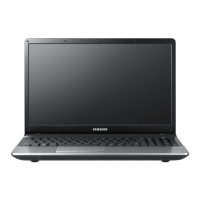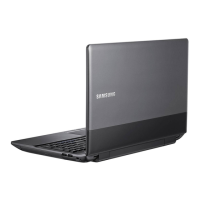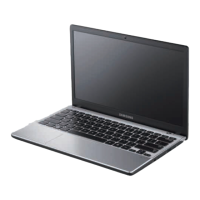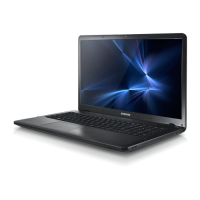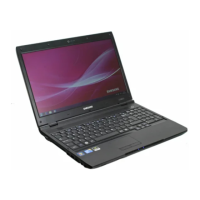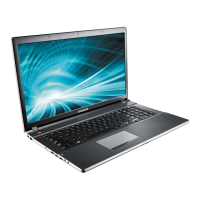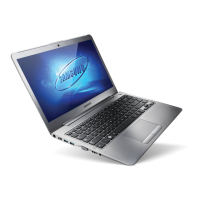Do you have a question about the Samsung NP300E5E and is the answer not in the manual?
Introduces the user guide and provides important initial information.
Details critical safety instructions to prevent injury and damage.
Provides guidelines for ergonomic computer usage to prevent physical harm.
Introduces the computer's front, status, right, left, and bottom views.
Explains the procedure for powering the computer on and off.
Explains the Windows 8 operating system and how to access its help.
Describes the Start screen and Desktop modes of Windows 8.
Explains how to activate and use the Charms menu for quick access to functions.
Covers starting, exiting, and managing applications in Windows 8.
Lists useful keyboard shortcuts for Windows 8 functions.
Details keyboard layout and shortcut key functions.
Explains touchpad functions, gestures, and settings.
Provides instructions on using the optical disk drive.
Explains how to use the multi-card slot for data storage.
Guides on connecting monitors and TVs via D-SUB and HDMI ports.
Describes how to control audio volume using keyboard and software.
Explains how to adjust screen brightness to save power.
Details how to connect to a wired LAN and configure network settings.
Explains how to connect to a wireless LAN and AP.
Covers setting up and using the Trusted Platform Module for security.
Introduces S Camera, S Gallery, and S Player apps for media.
Explains how to update Samsung software and drivers.
Guides users on using the Support Center for troubleshooting.
Explains how to use the security slot for physical security.
Explains how to enter and navigate the BIOS setup utility.
Details how to set up supervisor, user, and HDD passwords for security.
Guides on modifying the boot device order in BIOS.
Provides instructions for adding or replacing memory modules.
Covers battery installation, charging, and usage time management.
Explains how to restore the system and back up data.
Provides steps for reinstalling the Windows operating system.
Addresses common questions about recovery, Windows 8, and display issues.
Covers essential safety instructions for system setup and use.
Discusses using recommended parts, cords, and battery disposal.
Details wireless guidance, FCC, CE, and Canadian compliance.
Explains proper disposal of electronic waste and batteries.
Information on Samsung's packaging recycling program.
Lists system specifications for CPU, memory, storage, and graphics.
Defines technical terms used in the user guide.
Provides an alphabetical list of topics and their page numbers.
| Bus type | DMI |
|---|---|
| Stepping | L1 |
| Tjunction | 90 °C |
| Processor cache | 3 MB |
| Processor cores | 2 |
| Processor model | i3-3110M |
| System bus rate | 5 GT/s |
| Processor family | Intel® Core™ i3 |
| Processor series | Intel Core i3-3100 Mobile Series |
| Processor socket | BGA 1023 |
| Processor threads | 4 |
| Processor codename | Ivy Bridge |
| Processor frequency | 2.4 GHz |
| Processor cache type | Smart Cache |
| Processor lithography | 22 nm |
| Processor manufacturer | Intel |
| Processor front side bus | - MHz |
| PCI Express slots version | 2.0 |
| Processor operating modes | 64-bit |
| ECC supported by processor | No |
| PCI Express configurations | 1x16, 2x8, 1x8+2x4 |
| Thermal Design Power (TDP) | 35 W |
| CPU multiplier (bus/core ratio) | 24 |
| Maximum number of PCI Express lanes | 16 |
| Motherboard chipset | Intel® NM70 Express |
| Memory slots | 2x SO-DIMM |
| Internal memory | 4 GB |
| Memory clock speed | 1333 MHz |
| Memory form factor | SO-DIMM |
| Internal memory type | DDR3-SDRAM |
| Maximum internal memory | - GB |
| HDD interface | SATA |
| Storage media | HDD |
| Optical drive type | DVD Super Multi DL |
| Card reader integrated | Yes |
| Total storage capacity | 500 GB |
| Compatible memory cards | SD, SDHC, SDXC |
| Number of HDDs installed | 1 |
| Display diagonal | 15.6 \ |
| Display brightness | 200 cd/m² |
| Display resolution | 1366 x 768 pixels |
| Native aspect ratio | 16:9 |
| On-board graphics card ID | 0x166 |
| Discrete graphics card model | - |
| On-board graphics card model | Intel® HD Graphics 4000 |
| On-board graphics card family | Intel® HD Graphics |
| On-board graphics card base frequency | 650 MHz |
| On-board graphics card dynamic frequency (max) | 1000 MHz |
| Audio system | HD |
| Speaker power | 1.5 W |
| Wi-Fi standards | 802.11b, 802.11g, Wi-Fi 4 (802.11n) |
| Bluetooth version | 4.0 |
| Cabling technology | 10/100Base-T(X) |
| Networking standards | IEEE 802.11b, IEEE 802.11g, IEEE 802.11n, IEEE 802.3, IEEE 802.3u |
| Ethernet LAN data rates | 10, 100 Mbit/s |
| Charging port type | DC-in jack |
| USB 2.0 ports quantity | 3 |
| USB 3.2 Gen 1 (3.1 Gen 1) Type-A ports quantity | 0 |
| Pointing device | Touchpad |
| Operating system installed | Windows 8 |
| Form factor | Clamshell |
| Product type | Laptop |
| Product color | Silver |
| Battery capacity | 48 Wh |
| Battery life (max) | - h |
| Number of battery cells | 6 |
| Cables included | AC |
| Processor code | SR0N2 |
| Processor ARK ID | 65700 |
| Processor package size | 37.5 x 37.5 (rPGA988B); 31 x 24 (BGA1023) mm |
| Supported instruction sets | AVX |
| Intel Identity Protection Technology version | 1.00 |
| Depth | 248 mm |
|---|---|
| Width | 376 mm |
| Weight | 2200 g |
| Height (rear) | 31.8 mm |
| Height (front) | 25.2 mm |
